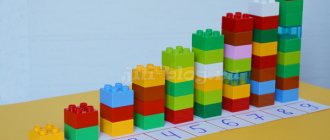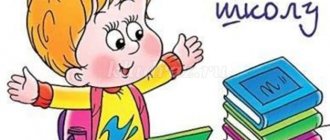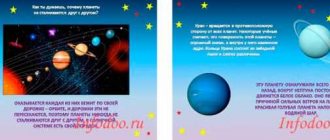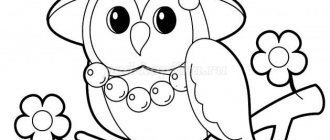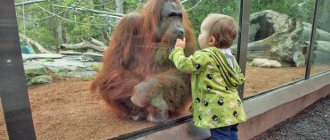Presentation for children “Math for Kids”
Content
Presentation on the topic: Mathematics for kids
Download this presentation
Download this presentation
Slide No. 1 Slide description:
“Content of cognitive and mathematical activities in the daily routine” 900igr.net
Slide No. 2 Slide description:
The main thing is to teach a child to think. A preschooler with developed logical thinking always has a greater chance of being successful in mathematics, even if he was not previously taught the elements of the school curriculum.
Mathematics is a powerful factor in the intellectual development of a child, the formation of his cognitive and creative abilities. Introducing a child to numbers, teaching him to count, add and subtract is not the main thing when preparing for school. Slide No. 3 Slide description:
Many psychologists and teachers (P.Ya. Galperin, A.N. Leushina, T.V. Taruntaeva, etc.) believe that the formation of mathematical concepts in preschoolers should be based on object-sensory activity.
K.D. Ushinsky wrote: “When initially learning to count... one should also not rush and go further only after mastering the previous one, and having mastered something, never leave it without constant application to the task.” All this makes the problem of consolidating and applying elementary mathematical concepts in the classroom, outside of them in the daily routine and in everyday life relevant today. Slide No. 4 Slide description:
Does a tiny baby need math?
Basic mathematical concepts are simply necessary for a child. This includes the ability to navigate in space and such concepts as size and shape, and the simplest logical and arithmetic operations. Without these first standards, the baby will not be able to fully master the world around him. Mathematics develops the baby’s intellect in the best possible way, teaches him to think and analyze. But you also need to develop children’s intelligence wisely. And this is best done in everyday games and activities. A sort of “natural” mathematics. Slide No. 5 Slide description:
Junior group I is the same “mathematical” age when it is very important for a child to get acquainted with the properties of objects, realize their connection with each other, master the basics of synthesis and analysis, and understand the simplest everyday logic.
What could be the best material for a child’s non-boring education? Of course, toys. It is cubes and balls, pyramids and nesting dolls, dolls and soft animals that will help you easily and cheerfully explain difficult concepts to your child. When building a tower or house, your child will quickly remember the names of geometric shapes if you name them more often. Mathematics in between Slide No. 6 Slide description:
Teaching your child the simplest logical operations is not only possible, but also necessary.
For example, the simplest classification. Say the names of groups of objects more often, i.e. generalizing words. You can play a game where you need to divide objects into groups depending on a given characteristic. First, you can cut out silhouettes of cars, animals, vegetables, fruits, etc. from cardboard. With such didactic material it is good to master counting. Geometric shapes of three sizes and four colors will be universal. You can select a wide variety of combinations from them: only figures with corners, without corners, both large and yellow, all small, not round and not red, etc. You need to teach your baby to count using specific objects. And link the score specifically to specific apples, balls, candies or cars. They move on to abstract numbers later. In the meantime, the most important thing for a child is awareness of quantity, a clear understanding that this concept does not depend either on the size of counting objects, or on their shape or color. Illogical logic Slide number 7 Slide description:
You can also do mathematics during outdoor games.
Any knowledge is learned better and easier if the child’s gross and fine motor skills are used during classes. March with the children first to the count of “one-two”, then to the count of “one-two-three”, and then “one-two-three-four”. On the count, you can jump on two legs, squat, lean forward or to the sides. While playing with the ball, throw or roll it across the floor to each other while calling out numbers. You can find plenty of such outdoor games. Mathematics in motion Slide number 8 Slide description:
Walking with mathematics You can do mathematics while walking.
The simplest thing you can think of is to count certain objects you encounter. Say the following phrases more often, for example: “Look, there are two red cars and two blue ones. There are four in total. Two boys and three girls are playing in the sandbox. There are only five children." So you will gradually master the composition of the number. Invite your child to look for “everything that has two” on a walk. It's not easy, but it's interesting. While walking, it is very convenient to get acquainted with the concepts: “thick - thin”, “far - close”, etc. Slide No. 9 Slide description:
Consolidation and application of elementary mathematical concepts of preschoolers in the classroom and in the daily routine. One of the most important tasks of the educator is to ensure that the knowledge, skills and abilities that children receive in the process of GCD in mathematics are used by them in different life conditions - in other activities, in games, in everyday life, while walking.
Children must understand that they really need the knowledge they have acquired and have learned to use it. This will further develop children's interest in mathematics and expand their knowledge. It is necessary that this process be connected with all aspects of the educational work of a child care institution and aimed, first of all, at solving the problems of mental education and mathematical development of preschool children. Slide No. 10 Slide description: Slide No. 11 Slide description:
During table setting, the attendants compare the number of cutlery and the number of children.
During applique classes, children are convinced that the number of objects does not depend on their location. While playing on the site while walking, you can measure the distance between trees, compare different types of equipment in length, width, height. During classes in productive activities (modelling, drawing, designing), children’s ideas about geometric shapes, the shape, size of objects, their spatial arrangement, and quantity are reinforced. By training children in the construction of various buildings from building materials and construction sets, designing according to drawings, drawings and diagrams, children’s ideas about geometric shapes and shapes are consolidated. This promotes the development of imagination, creativity, inventiveness, and the ability to make non-standard solutions. Knowledge of different shapes and sizes, knowledge of spatial relationships between objects provide children with significant assistance in developing the ability to “read” technical drawings. Slide No. 12 Slide description:
For subject and subject drawings, for ornament and appliqué, for modeling from plasticine, making toys, knowledge of shape, size, quantitative and spatial relationships between parts of an object or between the objects themselves is required, therefore geometric concepts and measuring skills develop and consolidate in all types of visual activities.
Music classes reinforce spatial concepts and counting skills. Together with the music director, children become familiar with the basic properties of musical sound - height, the direction of melodies up and down; with the duration of sounds (longer - shorter), etc. Children associate these basic properties of musical sounds with spatial, temporal, quantitative concepts: further - closer; higher lower; longer - shorter, etc. Slide No. 13 Slide description:
In physical education classes, children often encounter quantitative and ordinal counting in constructions.
For example, they line up in two or three columns, disperse in pairs to the right and left, form circles, march around the hall in a rectangle, emphasizing the corners at turns, run “in a circle”, “loosely”, “snake”, etc.). When performing various types of exercises, the ability to navigate in space is consolidated: right and left sides, turns in a semicircle, in a circle, etc. Children's ability to navigate time and space is also widely used in various outdoor games. Classes to familiarize children with their surroundings and classes to develop speech also give children a lot in terms of mathematical development. For example, children keep a more accurate calendar of nature, using their knowledge of months, weeks, and days. Having realized the fluidity and duration of time, children notice how long it is light in different seasons. Slide No. 14 Slide description:
When caring for plants in a natural corner, in a vegetable garden, flower beds, children measure growth, count the number of buds, flowers, note what happens first, what happens next, note the sequence of actions.
During excursions to nature, to a park or around the city, children’s ability to navigate in space is also strengthened. When collecting leaves from the area, we draw the children’s attention to the shape of the petals, their structure, and count their number. When preparing natural materials, children collect and stack dozens of pine cones, bones or pebbles. The group count is fixed here. Slide number 15 Slide description:
Playing for a child is a way of understanding the environment. By playing, he studies the color, shape, and properties of objects.
With the help of games, children’s ideas about numbers, the relationships between them, geometric shapes, time and spatial orientations are clarified and consolidated. Games promote the development of curiosity, observation, intelligence, attention, memory, thinking, speech, and stimulate children's activity in them. In a didactic game, children learn mental actions: analysis, synthesis, comparison, generalization, classification. Didactic games are various types of lotto that exercise counting and calculation skills, subject lotto for form; various paired pictures for quantity and numbers, for the size of objects and shape, for the spatial arrangement of objects, mathematical dictations, plot pictures for recognizing the time of year or part of the day. Slide No. 16 Slide description:
But mastering mathematical concepts with the help of didactic games will be effective only with the maximum participation of each child in educational and gaming activities.
Often, frontal forms, when all participants in the game receive the same tasks, and only one child voices the only answer at the board, become ineffective and do not allow the teacher to control the individual performance of game tasks by children. At the same time, children have the opportunity to copy the work of their comrades unnoticed by the teacher; they internalize stereotypes and cease to strive for conscious, independent and creative performance of game tasks. Slide number 17 Slide description:
It is possible to overcome the emerging formalism in the use of didactic games in several ways. Method one: using a variety of visual material on the basis of which the game is played.
Method two: introducing new variants of tasks, materials, game conditions. Method three: children work with individual cards. Method four: organizing playful communication between children in the form of playing in pairs. Method five: organizing playful communication between children in small groups of three to four people. Method six: organizing a game with the entire group of children at the same time. Method seven: maintaining a lively (feasible for preschoolers) pace of play, which helps to intensify the children’s actions. Method eight: creating a joyful mood in children while playing. Slide number 18 Slide description:
With the help of mathematical competitions, you can solve a number of important learning tasks: consolidate, clarify, test children’s previously acquired knowledge;
learn to apply acquired knowledge in changed or life situations; develop perception, memory, thinking, imagination, speech; develop the ability to analyze perceived material, highlight the main thing in it, generalize it, compare, draw conclusions; develop intelligence, attention, observation, quick thinking, memory for numbers; activate mathematical vocabulary in speech, learn to express thoughts in simple and common sentences, coherently, understandably for those present. Slide No. 19 Slide description:
The practice of using elementary mathematical concepts in the classroom, in the daily routine, and in everyday life creates sufficient conditions for the strong consolidation of mathematical knowledge acquired by each child in direct educational activities. This form of the educational process: helps the child acquire solid knowledge, skills and abilities ;
ensures the development of independence and confidence; creates interest in the quantitative side of reality; has a positive impact on the further learning of mathematical material at school. Slide No. 20 Slide description:
Thank you for your attention!
ppt4web.ru
Final lesson on FEMP in the younger group with presentation
Abstract of an open educational activity with the presentation “Travel with a Kolobok”
Author: The lesson and presentation were prepared by the teacher of MKDOU No. 233 Anna Anatolyevna Pashnina Description: This abstract using ICT is intended for educators working with children of primary and secondary groups. Integration of educational areas: “Cognition”, “Communication” Goal: To create conditions for the development of elementary mathematical concepts in a playful way, to develop the cognitive activity of children. Objectives: Educational:
- Teach children to conduct a dialogue with the teacher: listen and understand the question asked;
— To consolidate children’s knowledge about geometric shapes (circle, square, triangle), how they differ from each other; - Strengthen the ability to distinguish between the concepts: “as many - how many”, “none”, “one”, “many”; — Strengthen the ability to distinguish and name primary colors, compare objects by size, establish equality; — Exercise the ability to compare objects by color, size, shape. Developmental:
- Develop observation, attention, logical thinking, auditory and visual imagination;
— Develop in children the ability to think creatively; — Develop children’s speech; — Expand and activate the vocabulary. Educators:
- Foster a desire to help others;
— Cultivate an emotionally positive attitude towards mathematical games. Material: ICT (laptop, projector, audio speaker), presentation. Picture - a train, cars without wheels, Gyenish blocks, 4 cups, 4 spoons, square, round, triangular boxes (different colors), mushrooms, apples, a plate for pies, pictures of butterflies, flowers, toys.
Progress of the GCD
The teacher is part of the group together with the children. Educator: Guys, guests came to us today. Let's say hello to our guests. Good morning, smiling faces! Good morning to the sun and birds! Good morning, everyone on the planet Good morning, the children will say to everyone Good morning, our guests We wish good morning to all of us! Educator: Guys, do you like to travel? (Slide 1).
Do you like fairy tales?
This morning I met a hero from a fairy tale. He said that he really wants to meet you and take you on a fun trip. Do you want to meet him? Then guess the riddle: (Click) (slide 2)
Didn’t lie on the window, Rolled along the path... (gingerbread man).
(Click). Educator: That's right, this is a bun. And here he is. (Square shaped bun). Is there something wrong with him? Is this a bun? (No.) What shape is this bun? (square). What does he look like? (Cube) What shape is a real bun? (round) (Click) (Slide 2)
(a round shaped bun appears).
That's right, it's round. What does he look like? (ball, ball). Educator: Everything is clear, he decided to play a trick on us. Do you know a fairy tale about him? What happened to him at the end of the fairy tale? And today we will go on a journey to a new fairy tale about a little boy who loves mathematics. And to find out what we will go on our journey on, do you need to guess the riddle? The leaves of the crowns wave after him, And the carriages run behind him. It rushes merrily along the rails to the sound of wheels.... (Steam locomotive)
Colored carriages keep running along the rails.
And the round wheels go on and on and on. (Lay out a train with carriages, but without wheels.) Educator: Guys, look, what is this? (train)
Is there something wrong with him?
(The carriages have no wheels.) Educator: For some reason it has no wheels, did something happen? He wanted to take us to the forest, but on the way he probably lost his wheels. Let's help him find his wheels! Come to the table, there are different figures in the box. (Dyenish blocks)
The teacher takes a triangle from the box.
Take everything to yourself in one figure. What is the name of this figure? (triangle)
.
Let's trace the triangle with our finger. How many angles? (three)
.
Try rolling the triangle across the table. It turns out? (no,
why?
(corners get in the way)
.
Can triangles make wheels? (No)
.
Let's put the triangles in the box. How many triangles did you put in the box? (1)
and how old are you?
(1)
.
Everyone put one triangle, but how many figures were there in the box? (a lot of)
.
Let's take other figures (the teacher suggests taking squares)
.
Take one such figure each. What is the name of this figure? (square)
.
Does a square have corners? (yes)
How many angles?
(four)
Point them with your finger.
Let's count (one, two, three, four)
Show the sides.
Let's try to roll the squares, can we make wheels out of them? (no,
why?
(corners get in the way, don’t roll)
.
Put them in the box, you'll have to look for other wheels. Only these figures remain in the box (the teacher takes out the circles)
.
Take one such figure each. What is the name of this figure? (circle)
Can a circle roll?
(yes)
Is there anything stopping you?
(there are no corners, nothing interferes with rolling)
.
Do you think we can make train wheels out of circles? (yes)
Take one wheel at a time and let’s go and fix the train.
The train has been repaired. (Click) (Slide 3 along with the music “Bukashka the Steam Locomotive”).
Well, now let's go to the forest!
Cling to me, you will be my trailers. We hit the road. Educator: Look, here is the forest. (Click) (Slide 4)
What grows in the forest (trees).
What kind of trees? (High and low, different). What does the tree have? (Trunk and branches). How many trunks? (one), and what about branches? (A lot of). (Click) (Slide 5)
Animals live in the forest: wolf, hare, fox, dog, bear.
Is everything correct? Who's the odd one out? Why? (the dogs are domestic, and the rest are wild.) And in the forest, flowers still grow and butterflies fly. (On the board) Let's count how many butterflies there are (5), and how many flowers there are (4). Let's plant each butterfly on a flower. Is there enough space for all the butterflies? (No). What are fewer flowers or butterflies? (colors). What needs to be done so that there are equal numbers of butterflies and flowers? Educator: Guys, let's remember when the bun left his grandparents, who was the first person he met in the forest? (Click) (Slide 6)
(hare).
(An image of a hare appears) Educator: Look at the hare. What does a hare like to eat? (Carrot). For some reason he is sad. Educator: Bunny has prepared gifts for his friends and he needs to put them in boxes and send them out. So that each parcel contains as many items as the number on the box shows. Lay it out. Mushrooms in a red, round box for the squirrel. What is the number on the box (5). How many mushrooms will we put? (5). We put one at a time. Apples in a green square for a hedgehog. What is the number on the box (4). How many apples will we put? (4). We count (1,2,3,4,5). At the same time, I clarify how much they put in (4.5). How many parcels are empty? (none) how many unarranged apples and mushrooms (none) are left on the table? Educator: We helped the bunny. Who did the bun meet next? (Click) (Slide 7)
(Wolf).
(An image of a wolf appears.) And the wolf builds houses. He has a lot of work to do. He needs help. Let's help the wolf build houses like these (Click) (Slide
(children build houses from cubes). Which houses turned out to be the same or different. And how do they differ? (Color, shape and size).
Educator: We helped the wolf. Who did the bun meet next? ? (Click) (Slide 9)
(Bear). (An image of a bear appears). Bear says that while he was in the forest, Masha came to his house and made a mess of the toys. The bear really asks for help putting things in order. Let's help, Bears to put things in order? First you need to put a steam locomotive, then a tumbler, and then a spinning top and a pyramid. (Game “Which is on the count”, “What has changed?”).
Educator: Who did the bun meet next? (Click) (Slide 10)
(Fox) . We walked and walked and came to the little fox's little sister's house. The little fox is not at home now. She's waiting for guests. Let's give the little fox a surprise, let's help set the table for 3 guests. How many cups do you need? (3), and for the hostess herself? (one more .) How many in total? (4). How many spoons do you need? (also 4). Now there are cups and spoons? (Equal parts). So that she doesn’t eat the bun, you need to bake her pies.
Listen carefully which ones: not blue and not red (there are boxes with Dienesh blocks). Which ones? (yellow). Not round and not square (triangular.) Educator: Well, we helped the kolobok and visited his friends, it’s time for him to return to his grandparents (Click) (Slide 11)
(Say goodbye to the kolobok),
(click) (Slide 11).
(Kolobok disappears).
It's time for us to go to kindergarten. Cling to me, you will be my trailers. We are going to kindergarten. (Click) (Slide 12).
So we returned to kindergarten
(Click) (Slide 13). Reflection: What fairy tale did we visit and who did we meet? Who did we help? (name the animals)
What did we do?
(They counted, built houses from blocks, and determined pies for the fox.)
Did you enjoy the trip? What did you like most? Is it good to help?
Presentation on the topic: Traveling with a kolobok
We recommend watching:
Summary of GCD in mathematics in the younger group. The use of non-traditional forms of work in mathematics GCD for children of the junior group in mathematics “Bigger, smaller, smallest” Summary of a lesson in mathematics 2nd junior group “Geometric figures” Summary of a lesson on FEMP in the 2nd junior group. Journey to Geometry
Similar articles:
Summary of a mathematical game in the second junior group
Summary of the game in mathematics in the younger group
Mathematics lesson in the younger group “Parts of the day”
Summary of the lesson in mathematics “Number and figure 2”. Junior group
Summary of a mathematics lesson in the junior group “Coding geometric shapes”
Planet of Childhood - Children's presentations on mathematics
Children's presentations are a convenient and accessible form of learning for children.
They allow you to diversify the learning process, make it brighter and more colorful. The main feature of the presentation is that it contains a thematic set of information that the child will learn in a very short time. Memorizing material quickly occurs because several types of perception are connected at once - visual (the child sees a picture), auditory (the picture is accompanied by information). Of course, presentations cannot be the only source of information, but they allow you to introduce novelty into the learning process. In addition, they will allow the mother to go off on her own business, and the baby will be busy for a few minutes. When can I start showing children's presentations?
Presentations can be shown to a baby starting from 7-8 months. Of course, presentations for such children should have a number of features: firstly, clear sound, secondly, a small number of pictures, thirdly, a slower change of pictures. The ideal options for first presentations are presentations - nursery rhymes. You can show your child one or two presentations a day.
For children older than one year, thematic presentations can be included in the learning process. Viewing time per day should be no more than 5-10 minutes. Using presentations correctly will not harm your baby. His passive vocabulary will be enriched, which will subsequently have a beneficial effect on the speed and quality of his speech development.
Presentations on the website in avi format. You can save them to disk and watch them on TV, the computer will be at your disposal.
On the website you can find children's presentations on the following topics:
You might be interested in the top five most popular development apps
our website:
1) Collection of “Smart Notebooks” - we master new concepts and develop useful skills.
2) Educational cards - for playing and learning, a large collection.
3) Developmental lacing - we develop fine motor skills and gain new knowledge.
4) Applications - our applications are not only creativity, but also development.
5) Copybooks - designed specifically for kids, very bright and colorful.
www.razvitierebenka.net
